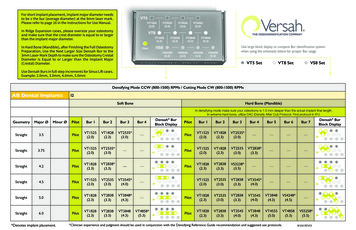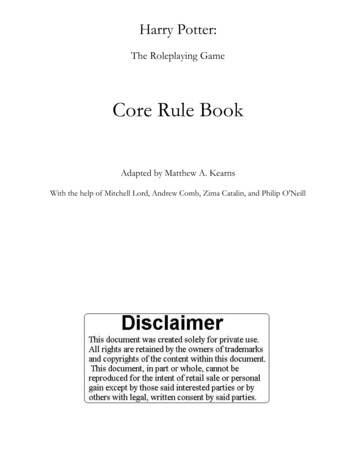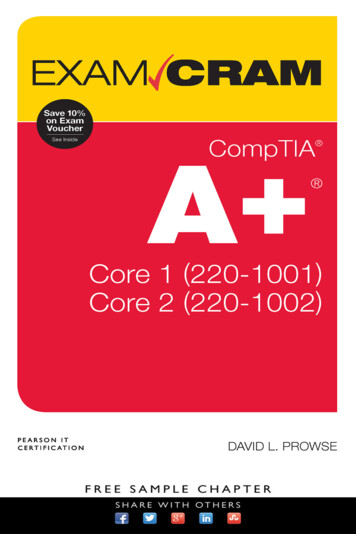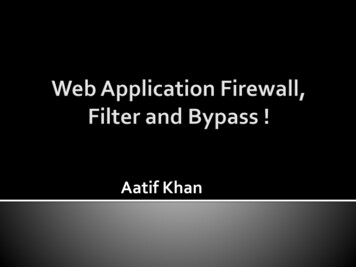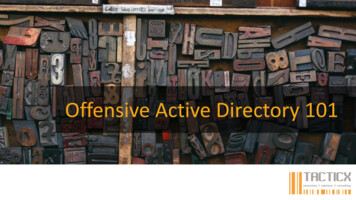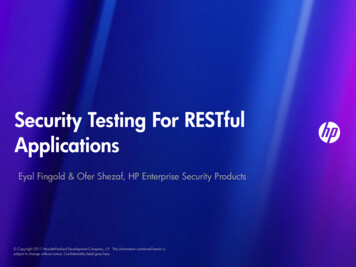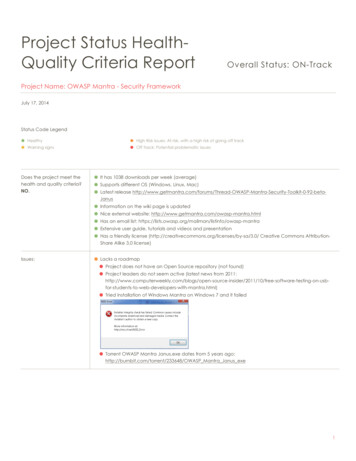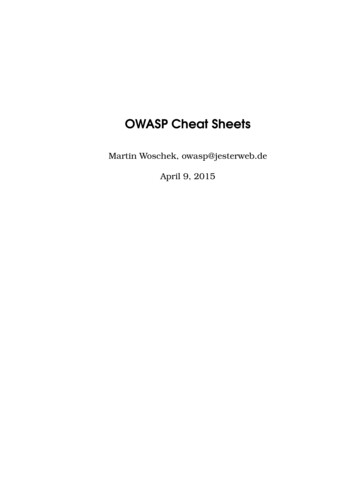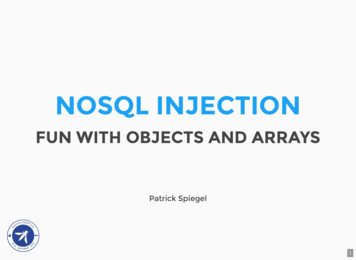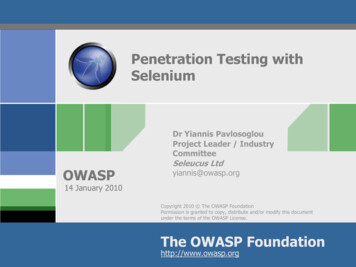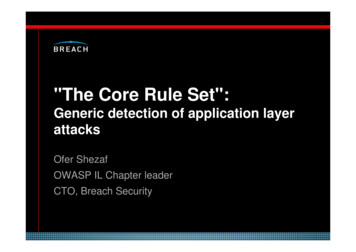
Transcription
"The Core Rule Set":Generic detection of application layerattacksOfer ShezafOWASP IL Chapter leaderCTO, Breach Security
Breach & the Community ModSecurity – open source WAF Recently purchased and kept as open source Most popular Web Application Firewall on the globe Ivan Ristic who wrote it and Ryan Barnett community leaderjoined us Web Application Security Consortium: Web Application Firewall Evaluation Criteria - Ivan Web Attacks Honeypot Project - Ryan Web Hacking incidents Database – Ofer Member of the board of directors - Ofer OWASP IL chapter leadership
Breach SecurityModSecurity CommunityModSecurity 2.0 Long awaited update to ModSecurity Significantly enhanced analysis engine XML parsingModSecurity Console Provides GUI event viewing Consolidation from multiple ModSecurity sensorsModSecurity Core Rules Package of signatures certified to be efficient and accurate by Breach Labs Coverage for most common web application threats
Web Application Firewallsvs.Intrusion Prevention Systems
Deployment - Network-level deviceDoes not require network re-configuration.
Deployment - EmbeddedDoes not require network re-configuration.
Three Protection Strategies for WAFs1.External patching Also known as "just-in-time patching" or "virtual patching".2.Positive security model An independent input validation envelope. Rules must be adjusted to the application. Automated and continuous learning (to adjust for changes) is the key.3.Negative security model Looking for bad stuff, Mostly signatures based. Generic but requires some tweaking for each application.IPS?
Virtual Patching Testing reveals that the login field is vulnerable to SQLinjection. Login names cannot include characters besidealphanumerical characters. The following rule will help: LocationMatch " /app/login.asp " SecRule ARGS:username "! \w " "deny,log" /LocationMatch
Positive security LocationMatch " /exchweb/bin/auth/owaauth.dll " SecRule REQUEST METHOD !POST "log,deny"SecRule ARGS:destination " URL" "log,deny,t:urlDecode,t:lowercase"SecRule ARGS:flags "[0-9]{1,2}"SecRule ARGS:username "[0-9a-zA-Z].{256,}"SecRule ARGS:password ".{256,}"SecRule ARGS:SubmitCreds "!Log.On"SecRule ARGS:trusted "!(0 4)" /LocationMatch The same, but for every field in every application Very hard to create, requires learning by: Monitoring outbound traffic (match input to web server request) Caveats: JavaScript, Web Services Monitoring inbound traffic (normal behavior): Caveats: Statistics, attacks in learning period.
Positive SecuritySiteSite StatusSite MapURLsParameterTypesParameters
Negative SecurityAn IPS, but: Full parsing & validation of HTTP: Request, Headers, Content Validation to individual fields (field content, length, field count,etc). both request and response. Uploaded files. Anti Evasion features: Decoding Path canonizations Robust parsing (apache request line delimiters )
Rules instead of signatures Signatures Simple text strings or regular expression patterns matchedagainst input data. Not very flexible. Rules Flexible. Multiple operators. Rule groups. Anti-evasion functions. Logical expressions. Custom variables.
The Core Rule Set
Detection of generic app layer attacks Core Rule Set available for ModSecurity at: ml Probably translatable to any App Firewall Benefits from ModSecurity features: Anti Evasion Granular Parsing Detection Mechanisms: Protocol ViolationsProtocol PolicyGeneric Attack SignaturesKnown VulnerabilitiesBad RobotsTrojans & Anti-VirusError conditions
Protocol Violations Headers: All required headers are there: Host, Accept, User-Agent Host is not an IP address Content length a must for none GET/HEAD methods Characters: Valid encodingOnly printable for headersPrintable and formatting for parametersOnly NULL not allowed in international applications Requires minimal tweaking Exceptions for automated software used by the application
Protocol Policy Allowed and blocked: HTTP versionsMethodsFile extensionsContent-Types (request AND reply) Global limitations: Request size, Upload size, # of parameters, length of parameter. Requires setting, but easy to set: We offer tailored settings for common developmentenvironments. An easy (not generic) addition: envelope on valid URLs.
Signatures for generic attacks Signatures require knowing the attack vectors andtherefore are usually used for known vulnerabilities. Web applications are custom, and attacks may betargeted. Variations on attack vectors are very easy Hence, normal signatures are not suitable for applicationlayer protection. In many cases few exceptions can make signatures varyeffective: substring
Case study: 1 1 Classic example of an SQL injection attacks. Used many times as a signature. But, can be avoided easily using: Encoding: 1%3D1 White Space: 1 %091 Comments 1 /* This is a comment */ 1 All of the above
“1 1” continued And is actually not required at all. Any true expressionwould work: 2 1 An not necessarily a comparison or even an expression.In MS-Access all the following are true: 1, “1”, “a89”, 4-4
Rules instead of signatures All these are attack indicators: xp cmdshell “ “ valid but stinks select, union, delete, drop & script are valid English words Single quote is very much needed to type O'Brien “1” The following rules can help: Sequence: union . Select, Amount: script, cookie and document appear in the same input field Learning: select and a single quote (‘) in a field it never appeared in. Amount & learning: three triangular brackets ( or ) appear in a fieldleaned as free text.
Known VulnerabilitiesA recent snort rule - bugtraq 9349Exploit: http://www.example.com/athenareg.php?pass %20;whoamiSnort Rule:alert tcp EXTERNAL NET any - HTTP SERVERS HTTP PORTS(msg: "BLEEDING-EDGE WEB Athena Web Registration RemoteCommand Execution Attempt";flow: to server,established;uricontent:"/athenareg.php?pass %20\;"; aq,9349;classtype: web-application-attack;sid: 2001949; rev:4;)
The Core Rule Set: generic detection# Command injectionSecRule REQUEST FILENAME ARGS ARGS NAMES REQUEST HEADERS"(?:(?:[\;\ ]\W*?\b(?:c(?:h(?:grp mod own sh) md pp c) p(?:asswd ython erl ing s) n(?:asm map c) f(?:inger tp) (?:kil mai)l g(?:\ \ cc) (?:xte)?rm ls(?:of)? telnet uname echo id) \/(?:c(?:h(?:grp mod own sh) pp c) p(?:asswd ython erl ing s) n(?:asm map c) f(?:inger tp) (?:kil mai)l g(?:\ \ cc) (?:xte)?rm ls(?:of)? telnet uname echo id))\b \b(?:(?:n(?:et(?:\b\W*?\blocalgroup \.exe) (?:map c)\.exe) t(?:racer(?:oute t) elnet\.exe clsh8? ftp) w(?:g(?:uest\.exe et) sh\.exe) (?:rcmd ftp)\.exe echo\b\W*?\by )\b c(?:md(?:(?:32)?\.exe\b \b\W*?\\\/c) hmod\b\.{1,100}?\ .{1,3}x d\b(?:\W*?\\\/ \W*\b.))))" \"deny,log,id:950006,severity:2,msg:'System CommandInjection'"
The Core Rule Set: Virtual Patching LocationMatch :"/athenareg.php " SecRule ARGS:pass "\;" \"deny,log,t:urlDecodeUni,t:htmlEntityDecode, \t:lowercase,t:removeWhitespace,t:removeComments" /LocationMatch Or: LocationMatch :"/athenareg.php " SecRule ARGS:pass "!\w " \"deny,log,t:urlDecodeUni,t:htmlEntityDecode, \t:lowercase,t:removeWhitespace,t:removeComments" /LocationMatch
Bad robots Based on modifiable elements of the request: User-Agent header URL Generic headers Therefore: Not a real security measurement Offloads a lot of cyberspace junk & noise Effective against comment spam Can use RBL: Potential for FPs.
Trojans and Anti-Virus Check uploaded for Trojans: Check for access to Trojans: Known signatures (x key header) Generic file management output (gid, uid, drwx, c:\) Major problem at hosting environments Uploading is allowed.
Error conditions If all else fails Important for customer experience Makes life for the hacker harder
Thank You!Ofer Shezafofers@breach.com
ModSecurity – open source WAF Recently purchased and kept as open source Most popular Web Application Firewall on the globe Ivan Ristic who wrote it and Ryan Barnett community leader joined us Web Application Security Consortium: Web Application Firewall Evalu
